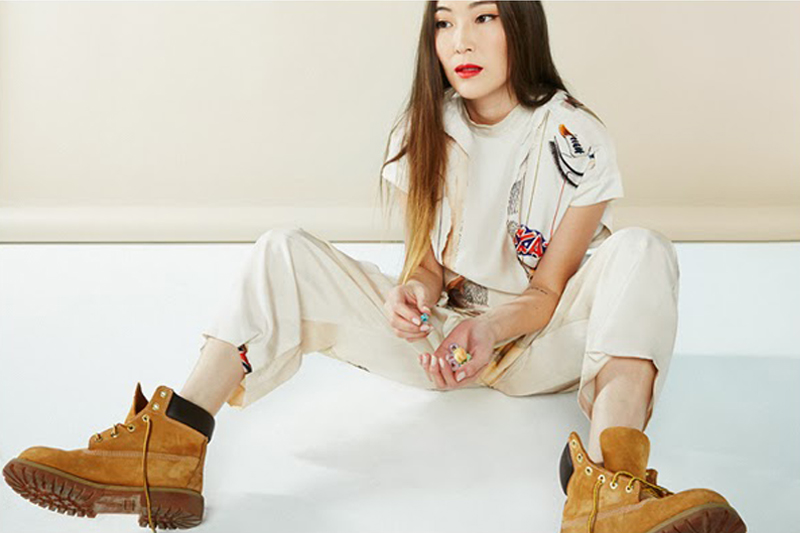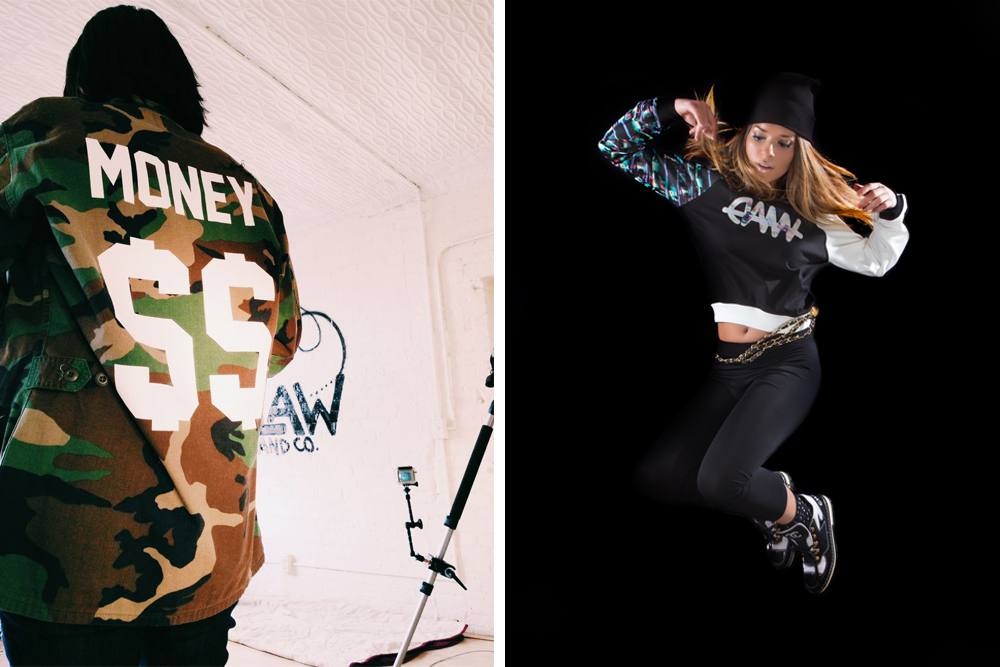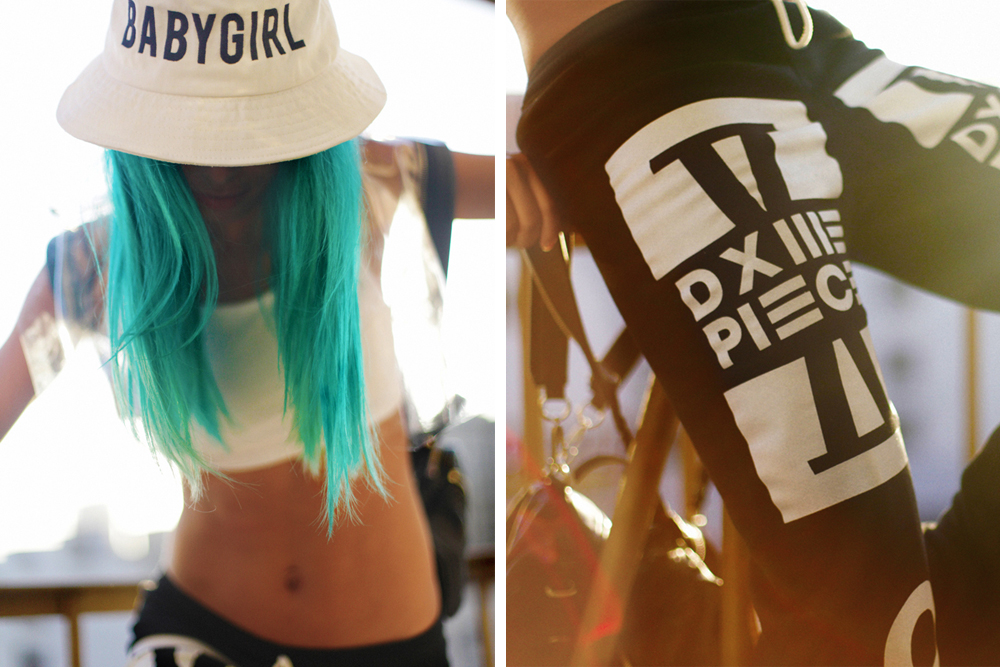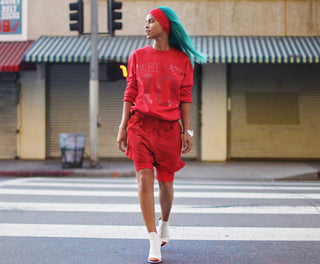Like many people, I discovered streetwear on the Internet. Around seven years ago, when I was 19, still living in London, and spending a slightly unhealthy amount of time “surfing the web,” I stumbled across a culture that seemed set on documenting its every T-shirt drop, stoop hangout, and summer block party online. Streetwear was the first sector of the apparel industry to recognize that selling a lifestyle was a great way to sell T-shirts – with this very website being perhaps the earliest progenitor of that idea – and I was a receptive voyeur. For a brief, golden moment before the Internet ruined all our lives, that virtual space populated by the heavily logoed kids of the LES and Fairfax was an exciting – even inspiring – place to be.
Much like the central London sneaker store where I landed a part-time job that same summer (and you best believe I blogged every in-store appearance and celebrity cameo, too) that place was also a sausage fest. But there were a few notable exceptions. I devoured Tabatha McGurr’s soul-bearing confessionals on the Married to the Mob blog, and followed the growth of a bad-ass label called Dimepiece in LA. For a while, the scene even jumped off the screen and across the pond when I attended the drop of the MOB Dunk at Nike’s 1948 store in Shoreditch, and the Soho exhibition launch of Claw Money’s lurid Vandal Hi. 19-year-old me was intrigued by this world of cool women running shit in hoodies and Jordans, where the female figureheads –Leah! Lanie! Vashtie! – were influential enough to be known by one name.
But by the end of that summer, I was already beginning to lose interest. The Internet, now mesmerized by the vacant smizing of a million female fashion bloggers, seemingly lost interest, too. The economy certainly lost interest. Male streetwear brands were hit hard by 2008’s financial suckerpunch but somehow continued to proliferate while their female counterparts (real or virtual) all but disappeared. But where to?

Joy Claire of ONE Distribution
Like me, many simply grew up. Men’s streetwear might be “full of Peter Pans who love retro references from their youth,” says ONE Distribution’s Joy Claire, but women’s brands must consistently deliver the new-new. For those handful of labels who basked in the golden glow of the mid-naughties streetwear surge, keeping the female consumer’s dollar meant expanding to a far wider demographic – as Married to the Mob has done – or facing sudden death. “A lot of [women’s brands] pinpointed the right girl at the right time,” says Dimepiece co-founder Ashley Jones, “but those girls grew up and the brands needed to do that with them.”
With the visible success (and failure) stories of women’s streetwear brands so few and far between, it would be easy to walk the aisles at the average tradeshow – where the male-to-female ratio is “frightening,” says Claire – and assume that the industry has become a girl-free zone. But a quick scratch of the surface reveals that women do continue to play a pivotal role in the contemporary streetwear market from the realm where they’ve long held their own: behind the blogs and behind the scenes.
For HUF co-founder Anne Freeman, there was never any other place to be. “My role was always going to be in the background because the industry is an entire network of brands that serve young men; it’s product that is explicitly made for them to consume,” she points out. “In order to market to that demographic, what place did I have?”
Instead, Freeman focused on capitalizing on the “gold rush” of the early 2000s scene. “Keith [Hufnagel, HUF’s namesake and co-founder] was a really talented athlete with a downtown New York edge and a lot of clout and I could see that he was the perfect frontman for a brand. I was the perfect behind-the-scenes partner; I was willing to play ‘bad cop’ and make some of the difficult business decisions that allowed Keith to focus on creativity and be the kind of boss that went skateboarding with his employees after work.” Still a silent partner in HUF, Freeman stepped back from hands-on management a couple of years ago to advise small apparel brands on financial structure, production flow, and distribution; the stuff she describes as the “grunt work” needed to make any brand a success.

Jayne Min of The Hundreds
At NYC brand 10 Deep, streetwear veteran Debbie Breslin has been holding it down 2005 – “also around the last time I had an official job title” – in a role that covers production sourcing, sales, and web store business management. Previously employed by Mecca USA and Akademiks (both of which grew from $5 million companies to $75 million companies under her tenure), she started her career in the corporate environs of the Seventh Avenue garment district, before moving to the burgeoning urban market in the mid-’90s. Breslin says she has remained in the streetwear scene precisely because it allows her to keep a low profile. “I could get up everyday and put on pantyhose and high heels to do all the things I know how to do, but instead I get to take those skills and work in a small environment, where we can be ourselves and have a good time doing it.”
Despite building a prolific online presence with her personal style blog Stop It Right Now, The Hundreds’ own Jayne Min echoes the preference for anonymity in the work sphere. Even in her powerful position as Head Designer of Apparel, Min insists that she’s “much more comfortable chugging along in the background,” and stresses her belief in keeping her ‘side internet persona’ as just that. “Work is work, life is life. Learn to compartmentalize – that’s what I always tell my assistants.”
For Min, the delineation is a choice. But Joy Claire observes that there “a lot of women who don’t get recognition” for the crucial roles they play in the streetwear industry. As a former staffer at UNDFTD and Union and now the marketing manager for SUPRA and KR3W, Claire says her experience and expertise have long been overlooked. “For so long I was seen as the girl behind the counter, when the reality is that I was the only one on the block with a college degree.” Similarly influential figures in the industry are rarely name-checked alongside their male counterparts.
But the disassociation works both ways. “Whenever I see this string of words – ‘women in streetwear’ – I get a little bit nervous,” Min says, articulating a common hesitancy among the women I spoke to. For Claudia Gold (aka legendary graffiti artist Claw Money, who launched her eponymous clothing line in 2007) the title is simply at odds with her personal brand. “I’ve always hated being lumped in with streetwear,” she says. “I don’t want to associate with a lot of those labels. I’m an artist who just happens to make clothes.”

Claudia Gold aka Claw Money and a lookbook shot from her line Claw and Co.
Beyond the nuances of marketplace positioning, identifying as a “woman in streetwear” now carries ambiguous connotations. In a world that exists as vividly on the Macbook screens of Internet trolls as it does on downtown city streets, the forefront of the industry is a vulnerable place for a woman to be. “Have you seen my Hypebeast comments?” asks illustrator Sophia Chang, whose client list includes Nike Sportswear, Puma and aNYthing. “They’re the most degrading thing ever.” (A work-focused feature documenting ‘A Day with Sophia Chang’ yields 59 comments, each more derogatory than the last. Sample quote: “Boner alert! Seriously, she is a cutie. I still have no idea what she does.”)
For those women whose faces spring up with a quick Google search, a career in the industry calls for a strict professional code. Joy Claire – who is listed as one of Complex magazine’s “10 Hottest Girls in Streetwear” – has learnt how to sniff out the guys with dubious intentions: “I have to be extremely forthright these days. I literally say: ‘If you’re interested in anything other than business then I’m not taking this meeting.'” Meanwhile, Chang says the “white tees and sneakers” uniform she developed as a student has served her well. “How you dress shows people how you want to be approached. I don’t show my cleavage or my legs because I don’t want men to feel they can look at me or talk to me in a certain way.”
Although wary of the pitfalls of working in a male-dominated industry, most women acknowledged these challenges are not exclusive to – or even especially prominent within – the streetwear world: “I think women have to be very smart about the balance of their sexuality in any workplace,” points out Freeman. “I had dozens of male employees over the years and I feel like it was easier for them to take me seriously because they had no idea what I looked like in my underwear.”

From DimePiece’s Spring 2014 collection
On the flipside, Claire acknowledges that “...being a woman in this industry does open doors – although if you don’t have any skills to back it up then there’s no point opening that door in the first place.” Once accepted into the streetwear boy’s club (“and it’s not a men’s club; it’s very much a boys’ club,” stresses Freeman) both male and female newcomers find themselves in an industry that thrives on creative collaboration and mutual support, where opportunities for entrepreneurial insiders are rife. “I have had a lot of help from my guy friends – whether professionally or personally,” says Gold, “and that allows me to be on a more equal playing field. Men have my back within the industry. I think that has given me an advantage.”
With Sophia Chang preparing to drop a new apparel collection with Puma, Joy Claire set to launch her own agency, and Gold gearing up for the launch of the rebranded ‘Claw & Co,’ it seems the path for women in streetwear is visible once again. For proof, see the introduction of the WMNS’s department at this week’s AGENDA tradeshow in Las Vegas; a concept initially launched at the show’s Long Beach basecamp, which offers a “curated, female-centric forum” for brands including Stussy Women, Married to the Mob, and Hellz Bellz.
DimePiece will also be attendance, showcasing the bold, feminist slogans that have recently been worn by Cara Delevigne, Miley Cyrus and Willow Smith. Beyond the strength of the celebrity endorsement, co-founder Laura Fama has noticed a revitalized appreciation for her brand’s empowering point of view. “We’ve been hustling and working in the same way for years, but recently feels like something just clicked,” says Fama from her office in downtown LA. “The energy of women is more on top than male right now; it’s the natural flow of what’s going with our generation. 2014 is the year of the woman, for sure.”

